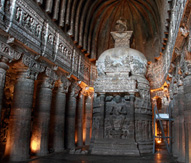 The cave temples of Ellora were excavated from the solid rock and symbolizes the three faiths of Hinduism, Buddhism and Jainism. Carved during the 350 AD to 700 AD period, these finest examples of cave - temple architecture houses detailed facades and exceptionally carved interiors.
The cave temples of Ellora were excavated from the solid rock and symbolizes the three faiths of Hinduism, Buddhism and Jainism. Carved during the 350 AD to 700 AD period, these finest examples of cave - temple architecture houses detailed facades and exceptionally carved interiors.
The caves opening to the west are equally associated to Buddhism, Hinduism, and Jainism. Out of total 34 caves, 12 caves to the south are Buddhist, the 17 in the centre dedicated to Hinduism, and the 5 caves to the north are dedicated to Jainism.
From south to north there are about 34 caves here, which corresponds more or less (Cave 21 with some significant exceptions) to the order in which they were constructed. The caves 1 to 12 in southernmost direction, are dedicated to Buddhism and were built in & around 7th & 8th centuries AD. The middle caves 13 to 29 are dedicated to Hindu deities, which dates back from 7th century to 9th century AD. The upper caves are related to Jainism (9th century).
These 3rd-century caves are fine achievements by Buddhist monks and are considered the finest masterpiece of Buddhist art and architecture.The caves are cut from the volcanic lava of the Deccan and are set in beautiful blooming surroundings. These historical manmade caves comprise of beautiful paintings on the walls and ceilings that depict the 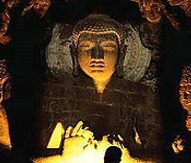 life of the Buddha. At Ajanta, the paintings on the walls, illustrate the events in the life of Gautama Buddha.
life of the Buddha. At Ajanta, the paintings on the walls, illustrate the events in the life of Gautama Buddha.
Udaipur City Palace is one of the architectural marvels of Rajasthan, located peacefully on the banks of Lake Pichola.
This majestic City Palace is the most-visited tourist attraction of Udaipur and often distinguished as the largest palace complex in Rajasthan. Initially, Maharana Udai Singh built this superb wonder, but the present form of the Palace is the result of subsequent additions by his successors. City Palace boasts of the wonderful blend of Medieval, European and Chinese Architecture. The Palace has various towers, domes and arches, which add to the flavor of heritage site. Towering on the banks of Pichola Lake, City Palace is truly a feast to the eyes. City Palace is a marvelous assortment of courtyards, pavilions, terraces, corridors, rooms and hanging gardens. Encircled by fortifications, this imposing Palace is wholly built in granite and marble.
Amber is located at a distance of 11 kilometers from Jaipur and was the old fort of the Kachhwaha clan of Amber, which used to be the capital, till it was moved to Jaipur.
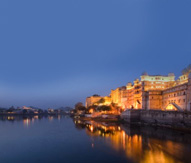 The construction of the Amber Fort began in the year 1592 and was started by Man Singh I, but it was finished by his descendant Jai Singh I. The exterior of the Fort is not in the least like its interiors. The outside is very imposing and rugged looking whereas the inside is a comforting and warm interior which is influenced by both Hindu and Muslim style of ornamentation. On the walls, are paintings depicting various hunting scenes, and there is also a lot of work on walls,
The construction of the Amber Fort began in the year 1592 and was started by Man Singh I, but it was finished by his descendant Jai Singh I. The exterior of the Fort is not in the least like its interiors. The outside is very imposing and rugged looking whereas the inside is a comforting and warm interior which is influenced by both Hindu and Muslim style of ornamentation. On the walls, are paintings depicting various hunting scenes, and there is also a lot of work on walls,
which are covered with intricate carving, mosaic and minute mirror work that make the halls look very majestic and imperial.
The fort is built with white marble and red sandstone and look even more attractive because of the Maota Lake in the foreground. The fort in itself is a beautiful sight to behold but as one looks on the fort with its clear reflection on the lake in the front, one cannot help but wonder if it is a dream or a beautiful illusion.
Taj Mahal is regarded as one of the eight wonders of the world, and some Western historians have noted that its architectural beauty has never been surpassed. The Taj is the most beautiful monument built by the Mughals, the 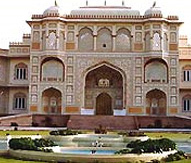 Muslim rulers of India. Taj Mahal is built entirely of white marble. Its stunning architectural beauty is beyond adequate description, particularly at dawn and sunset. The Taj seems to glow in the light of the full moon. On a foggy morning, the visitors experience the Taj as if suspended when viewed from across the Jamuna river.
Muslim rulers of India. Taj Mahal is built entirely of white marble. Its stunning architectural beauty is beyond adequate description, particularly at dawn and sunset. The Taj seems to glow in the light of the full moon. On a foggy morning, the visitors experience the Taj as if suspended when viewed from across the Jamuna river.
Taj Mahal was built by a Muslim, Emperor Shah Jahan (died 1666 C.E.) in the memory of his dear wife and queen Mumtaz Mahal at Agra, India. It is an "elegy in marble" or some say an expression of a "dream." Taj Mahal (meaning Crown Palace) is a Mausoleum that houses the grave of queen Mumtaz Mahal at the lower chamber. The grave of Shah Jahan was added to it later. The queen's real name was Arjumand Banu. In the tradition of the Mughals, important ladies of the royal family were given another name at their marriage or at some other significant event in their lives, and that new name was commonly used by the public. Shah Jahan's real name was Shahab-ud-din, and he was known as Prince Khurram before ascending to the throne in 1628.
Taj Mahal was constructed over a period of twenty-two years, employing twenty thousand workers. It was completed in 1648 C.E. at a cost of 32 Million Rupees. The construction documents show that its master architect was Ustad 'Isa, the renowned Islamic architect of his time. The documents contain names of those employed and the inventory of construction materials and their origin. Expert craftsmen from Delhi, Qannauj, Lahore, and Multan were employed. In addition, many renowned Muslim craftsmen from Baghdad, Shiraz and Bukhara worked on many specialized tasks.
The Taj stands on a raised, square platform (186 x 186 feet) with its four corners truncated, forming an unequal 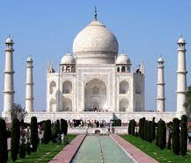 octagon. The architectural design uses the interlocking arabesque concept, in which each element stands on its own and perfectly integrates with the main structure. It uses the principles of self-replicating geometry and a symmetry of architectural elements.
octagon. The architectural design uses the interlocking arabesque concept, in which each element stands on its own and perfectly integrates with the main structure. It uses the principles of self-replicating geometry and a symmetry of architectural elements.
Its central dome is fifty-eight feet in diameter and rises to a height of 213 feet. It is flanked by four subsidiary domed chambers. The four graceful, slender minarets are 162.5 feet each. The entire mausoleum (inside as well as outside) is decorated with inlaid design of flowers and calligraphy using precious gems such as agate and jasper. The main archways, chiseled with passages from the Holy Qur'an and the bold scroll work of flowery pattern, give a captivating charm to its beauty. The central domed chamber and four adjoining chambers include many walls and panels of Islamic decoration.
The mausoleum is a part of a vast complex comprising of a main gateway, an elaborate garden, a mosque (to the left), a guest house (to the right), and several other palatial buildings. The Taj is at the farthest end of this complex, with the river Jamuna behind it. The large garden contains four reflecting pools dividing it at the center. Each of these four sections is further subdivided into four sections and then each into yet another four sections. Like the Taj, the garden elements serve like Arabesque, standing on their own and also constituting the whole.
